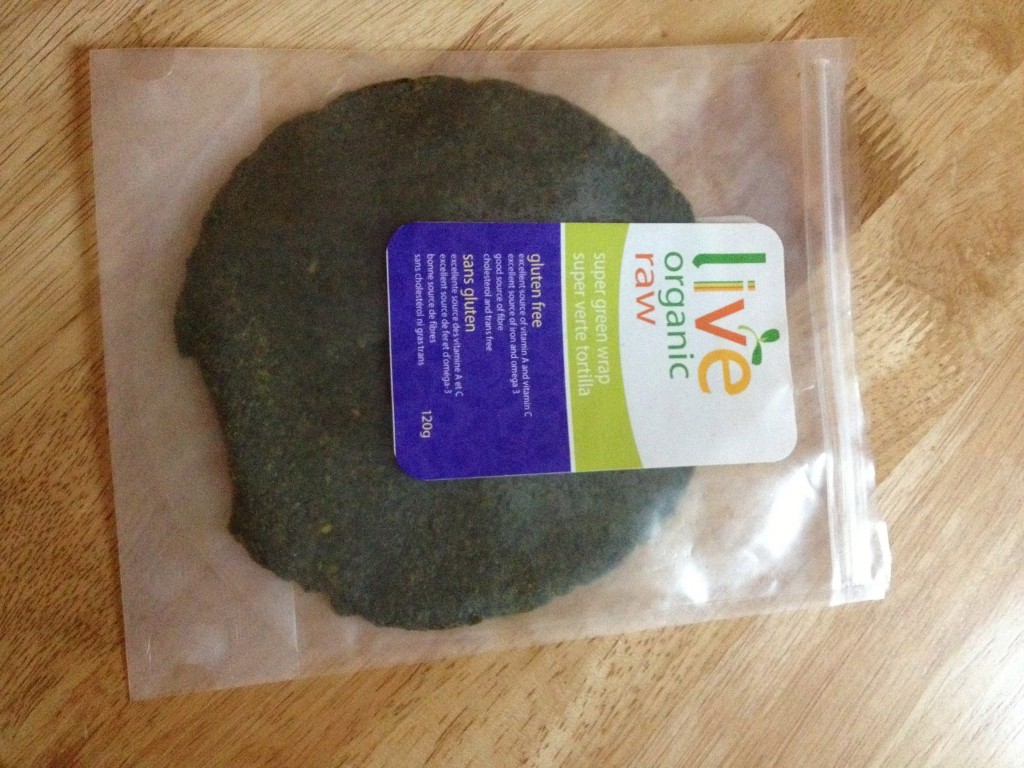 Vegan Green Wrap:
Vegan Green Wrap:
– The wrap is made locally in Toronto. (1)
* If you’re interested check out their Facebook page: https://www.facebook.com/pages/Live-Organic-Raw/358950207465482
– Where are the ingredients from?
– Spinach: most likely grown in Ontario (2)
(Also Henning was right, if you trace food back far enough you will make it to
Iraq or in this case Iran. Spinach is originally from Iran and began to be
grown in North America in the 19th Century)(2)
– Zucchini: most likely grown in Ontario (2)
– Golden Flax: most likely grown in the Prairies (3)
– Kale: most likely grown somewhere in Canada (4)
– Parsley: most likely grown locally
– Basil: most likely grown locally
– Coconut nectar: likely from Indonesia (5)
– Olive oil: most likely from the Mediterranean (6)
– Lemon juice: origin uncertain
– Chlorella: most likely from Japan (7)
– Salt: most likely from Ontario (8)
I think the most interesting ingredient to look further into is Chlorella. It is an edible type of algae that can be extracted into a liquid form. It is “a good source of protein, fats, carbohydrates, fiber, chlorophyll, vitamins, and minerals.” (7). I am interested in this since it is an alternative source of protein but I’m not sure if it is worth harvesting and then transporting half way around the world to be put into a wrap in Toronto.
Since I got to Toronto on the 30th of June I have eaten around two of these wraps a day because I find them super filling before a long day of dance. I had no idea I was eating any algae in my breakfast and lunch. I think it is strange that I really do not know what is in my food. I thought my breakfast would be easy to discuss because it was so basic. How have we gone from hunting and gathering, where what I grab is what I consume, to consuming some sort of processed product that contains ingredients you could not imagine?
With this in mind, I feel like it is important to mention the product was produced locally and bought locally. So the ingredients were brought to one source where they were then made into the product and then moved only a few kilometers to local stores. This takes out an entire step that I found with the other products, it didn’t have a long transportation to the store. I think this would significantly reduce the amount of fossil fuels utilized compared to an imported product.
Sources:
(1) “About Us.” Live, Organic, Raw. n.d. Web. 11 July 2013
(2) “Food Facts.” Foodland Ontario. Ontario Ministry of Agriculture and Food. n.d. Web. 11 July 2013.
(3) “Canadian Food Grade Flax.” Canadian Flax Suppliers. n.d. Web. 11 July 2013.
(4) Brown, L. “Harvesting in the winter is possible with little preparation.” CBC News. 17 Feb. 2009. Web. 11 July 2013.
(5) “Coconut Nectar – Organic.” Loving Earth. n.d. Web. 11 July 2013.
(6) “General FAQs of Olive Oil: from the North American Olive Oil Associations.” Holy Land Olive Oil n.d. Web. 11 July 2013.
(7) “Chlorella.” WebMD. n.d. Web. 11 July 2013.
(8) “Salt Resources.” Ontario Ministry of Natural Resources. n.d. Web. 11 July 2013.